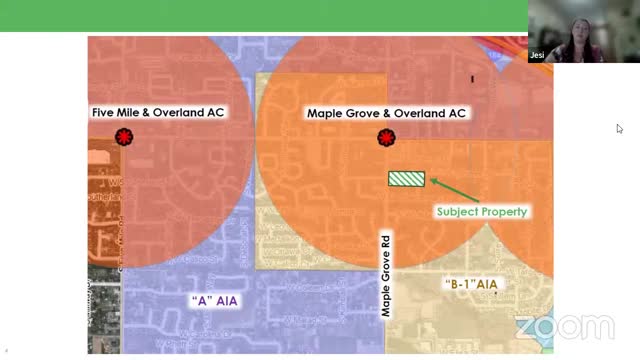Boise Airport fights proposed housing near air traffic zone
July 09, 2024 | Boise City, Boise, Ada County, Idaho

This article was created by AI summarizing key points discussed. AI makes mistakes, so for full details and context, please refer to the video of the full meeting. Please report any errors so we can fix them. Report an error »

In a recent government meeting, significant concerns were raised regarding a proposed increase in residential density near the Boise Airport, primarily due to potential conflicts with airport operations and noise impacts. Comments from the Boise Airport and the Idaho Air National Guard highlighted the necessity of preserving the airport influence area to accommodate future expansions and mitigate noise issues, especially as the Air National Guard prepares to transition to the louder F-16 jets by 2027.
The proposal, which seeks to increase density above five units per acre, was deemed incompatible with the existing suburban land use designation and the airport's operational needs. The area currently experiences substantial air traffic noise, and projections indicate that noise levels may rise with increased air traffic in the future. The airport's representatives emphasized the importance of maintaining the current zoning to protect both the airport's operational integrity and the community from potential noise disturbances.
Concerns were also raised about the proposed roadway design, which did not meet the required spacing guidelines and could lead to safety issues. The applicant's plan included a mix of multifamily homes and amenities, but feedback from the community indicated a preference for lower-density residential options, such as one to two-story buildings, to better transition to nearby commercial uses.
Public comments reflected a mix of support and opposition, with many residents expressing worries about traffic, privacy, and noise impacts from the airport. The FAA reiterated the importance of adhering to the airport influence area zoning to prevent non-compatible land uses that could lead to complaints and hinder future airport development.
As discussions continue, the commission is tasked with balancing the need for housing development against the critical operational requirements of the Boise Airport, ensuring that any decisions made will support both community growth and airport functionality.
The proposal, which seeks to increase density above five units per acre, was deemed incompatible with the existing suburban land use designation and the airport's operational needs. The area currently experiences substantial air traffic noise, and projections indicate that noise levels may rise with increased air traffic in the future. The airport's representatives emphasized the importance of maintaining the current zoning to protect both the airport's operational integrity and the community from potential noise disturbances.
Concerns were also raised about the proposed roadway design, which did not meet the required spacing guidelines and could lead to safety issues. The applicant's plan included a mix of multifamily homes and amenities, but feedback from the community indicated a preference for lower-density residential options, such as one to two-story buildings, to better transition to nearby commercial uses.
Public comments reflected a mix of support and opposition, with many residents expressing worries about traffic, privacy, and noise impacts from the airport. The FAA reiterated the importance of adhering to the airport influence area zoning to prevent non-compatible land uses that could lead to complaints and hinder future airport development.
As discussions continue, the commission is tasked with balancing the need for housing development against the critical operational requirements of the Boise Airport, ensuring that any decisions made will support both community growth and airport functionality.
View full meeting
This article is based on a recent meeting—watch the full video and explore the complete transcript for deeper insights into the discussion.
View full meeting